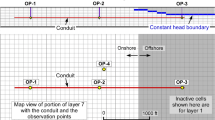Abstract
A simulation program, which works seamlessly with GIS and simulates flows in coastal aquifers, is presented in the present paper. The model is based on the Galerkin finite element discretization scheme and it simulates both steady and transient freshwater and saltwater flow, assuming that the two fluids are separated by a sharp interface. The model has been verified in simple cases where analytical solutions exist. The simulation program works as a tool of the GIS program, which is the main database that stores and manages all the necessary data. The combined use of the simulation and the GIS program forms an integrated management tool offering a simpler way of simulating and studying saline intrusion in coastal aquifers. Application of the model to the Yermasogia aquifer illustrates the coupled use of modeling and GIS techniques for the examination of regional coastal aquifer systems.
Résumé
Pour étudier un système aquifère côtier, nous avons développé un modèle aux éléments finis en quasi 3-D qui simule les écoulements d’eau douce et d’eau salée en régime aussi bien permanent que transitoire. Les équations qui les régissent sont discrétisées par un schéma de discrétisation de Garlekin aux éléments finis. Le modèle a été vérifié dans des cas simples où il existe des solutions analytiques. Toutes les données nécessaires sont introduites et gérées grâce à un logiciel de gestion de SIG. Le programme de simulation est utilisé comme un outil du logiciel de SIG, constituant ainsi un outil de gestion intégrée dont le but est de simuler et d’étudier l’intrusion saline dans les aquifères côtiers. L’application du modèle à l’aquifère de Yermasogia illustre l’utilisation couplée de la modélisation et des techniques de SIG pour l’étude des systèmes aquifères côtiers régionaux.
Resumen
Se ha desarrollado un modelo casi tridimensional de elementos finitos para simular el flujo de agua dulce y salada, tanto en régimen estacionario como en transitorio, en sistemas acuíferos costeros, bajo la hipótesis de separación por medio de una interfaz abrupta. Las ecuaciones del modelo han sido discretizadas mediante un esquema de Galerkin de discretización en elementos finitos. El modelo ha sido verificado en casos sencillos para los que existe solución analítica. Todos los datos necesarios se introducen y gestionan con un Sistema de Información Geográfica [SIG] por ordenador. El programa de simulación forma parte del programa de SIG, constituyendo una herramienta integrada de gestión para estudiar la intrusión salina en acuíferos costeros. La aplicación del modelo al acuífero de Yermasogia ilustra el uso acoplado de las técnicas de modelación y de SIG con el fin de examinar sistemas acuíferos costeros a escala regional.












Similar content being viewed by others
References
Bear J (1979) Hydraulics of groundwater. McGraw–Hill, New York
Essaid HI (1990) A multilayered sharp interface model of coupled freshwater and saltwater flow in coastal systems: model development and application. Water Resour Res 26(7):1431–1454
Gemitzi Α (2002) Simulation of coastal aquifers with the coupled use of finite elements and GIS (in Greek). PhD Thesis, Dept of Civil Eng, Aristotle University of Thessaloniki, Greece
Gemitzi A, Tolikas D (2001) Numerical and GIS coupling model for the study of saline intrusion in coastal aquifers: a case study from Yermasogia aquifer (Limassol, Cyprus). In Tsihrintzis VA, Tsalides P (eds) Proceedings in the International Conference “Ecological Protection of Planet Earth I”, vol 1. Xanthi, Greece, pp 33–42
Glover RE (1959) The pattern of fresh water flow in a coastal aquifer. J Ground Water Resour 64:439–475
Hubbert MK (1940) The theory of ground-water motion. J Geol 48(8):785–944
Huyakorn PS, Wu YS, Park NS (1996) Multiphase approach to the numerical solution of a sharp interface saltwater intrusion problem. Water Resour Res 32(1):93–102
Keulegan GH (1954) Ninth progress report on model laws for density currents; an example of density current flow in permeable media. National Bureau of Standards US Report 3411
Koutsos T (1998) Study of Yermasogia’s aquifer (Cyprus) with the use of GIS (in Greek). MSc Thesis, School of Geology, Faculty of Science, Aristotle University of Thessaloniki, Greece
MapInfo (2000) MapInfo Professional version 6.0, user’s guide. MapInfo Corp, New York
Polo JF, Ramis FJR (1983) Simulation of salt water–fresh water interface motion. Water Resour Res 19(1):61–68
Rumer RR, Harleman DRF (1962) Intruded saltwater wedge in porous media. US Geological Survey Professional Paper 450-B
Vappicha VN, Nagaraja SH (1975) Steady state interface in an unconfined aquifer with a vertical outflow face. Paper presented at the National Symposium on Hydrology, Rurkee, India
Vappicha VN, Nagaraja SH (1976) An approximate solution for the transient interface in a coastal aquifer. J Hydrol 31:161–173
Verruijt A (1968) A note on the Ghyben–Herzberg formula. Int Assoc Hydrol Soc Bull 13:43–45
Acknowledgements
The authors gratefully acknowledge the Cyprus Water Resources Development Dept. for providing the necessary hydrogeological data for Yermasogia’s aquifer to calibrate and check the validity of the developed model. This paper is part of a PhD thesis carried out by Ms A. Gemitzi and was supported by the National Scholarship Foundation of Greece.
Author information
Authors and Affiliations
Corresponding author
Rights and permissions
About this article
Cite this article
Gemitzi, A., Tolikas, D. Development of a sharp interface model that simulates coastal aquifer flow with the coupled use of GIS. Hydrogeology Journal 12, 345–356 (2004). https://doi.org/10.1007/s10040-003-0295-z
Received:
Accepted:
Published:
Issue Date:
DOI: https://doi.org/10.1007/s10040-003-0295-z




